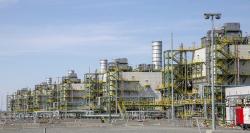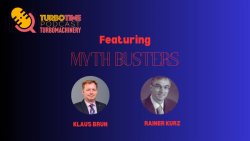
OR WAIT null SECS
© 2024 MJH Life Sciences™ and Turbomachinery Magazine. All rights reserved.
Rotating disk vibration - interaction resonance
As this is my initial submission on Dynamics & Acoustics, I should start with aspects of Wilfred Campbell’s “Campbell Diagrams”, Ref. [1].
This article will offer an explanation of “minor resonance” of disks, better-termed interaction resonance, and end with a suggestion to be cautious of a special aspect of turbine blading resonance analysis. Wilfred Campbell deserved his notoriety as many books and more than a thousand scholarly articles refer to his plotting method. In the 1920’s some steam turbine disks were too thin and fatigue failures lead to his explanation of disk critical speeds. Besides excitation due to upstream struts and stators, non-uniform circumferential flow can excite a disk critical speed. An example is when two times running speed is equal to a 2-diameter disk mode frequency; two opposite areas of the disk vibrate in phase while the two other areas are out of phase. Some disks vibrated so violently in the axial direction that the bladed disks reached adjacent stators and rubbed. It was considered a phenomenon of standing waves; researchers later provided visualization using flexible rubber disks. Modern machinery design is to avoid excitation at disk critical speeds, but in turbomachinery there are also what Wilfred Campbell termed “minor resonance” points.
From 1969 to the mid 1970’s it was perplexing to the writer when these minor resonances could be considered an issue leading to disk fatigue failures. There were occasional unexplained albeit rare failures of compressor impellers. Finally when strain gauges on impellers were used to solve recurring failures at an LNG plant, what is termed interaction resonance of bladed disks was discovered. The renowned vibration expert, MIT’s Prof. Den Hartog, since deceased, had met with the parties and other consultants before strain gauges were finally applied with slip ring data transfer. He related to the writer that case with multiple impeller failures, and two different crack patterns, was the most difficult problem he ever experienced. After months of testing and removing the cause of high excitation, severe liquid ingestion the question remained: what about future designs? While reviewing data somewhat later the puzzle was solved and response equations were developed to prove what “minor resonances” could really be important. The equations verified why the 5-diameter disk mode responded at a frequency equal to two times number of inlet vanes, while the 3-diameter mode did not respond to even higher excitation forces at one times the number of vanes. Strain gauges were essential to the discovery and also explained the other crack pattern was due to loss of aerodynamic damping causing flutter of the 2-diameter mode when in compressor overload with liquids.
The proof was published [2] in 1979 giving simplified equations, and again verifies why phase is so important in dynamics and acoustics. In this case, it was not only phase of the mode shape but also phase between stationary and rotating elements. Moreover the equations show that a disk critical is really not a phenomenon but can be especially troubling. The theory was later verified by others such as Jay ET. Al., [3] for a turbine disk and by Davis of NASA, [4] for turbopump impellers. The equations will be given in a future post along with an alternate plotting technique, “interference diagrams”. If details are needed in the meantime, interaction equations are repeated with details of the experimental proof in [5] along with design cautions.
Some have used interference diagrams for turbine disks with blades connected in packets while assuming all packets are identical. That can potentially be done for long blades where packet frequencies can be very close to each other. However as described in [5] for short blades, unavoidable mistuning gives individual packet frequencies that require checks with phase cancellation equations used for many decades.
References:
1. CAMPBELL, W. “The Protection of Steam Turbine Disk Wheels From Axial Vibration” ASME Transaction, Vol. 46, 1924, pp 31-160.
2. Kushner, F., 1979, "Disc Vibration - Rotating Blade and Stationary Vane Interaction", ASME Paper No. 79-Det-83: 1980 ASME Transactions, Journal of Mechanical Design, Vol. 102, pp. 579-584
3. Jay, R. L., MacBain, J. C., and Burns, D. W., 1983, “Structural Response Due to Blade Vane Interaction”, ASME Journal of Engineering for Gas Turbines and Power, 106, pp. 50-56.
4. Davis, G., NASA, 1990, “Fourier Analysis of Vibrations of Round Structures”, Marshall Space Flight Center, NASA Tech Brief MFS-29334, NTIS Order No. NTN90-0633.
5. Kushner, F., 2004, "Rotating Component Modal Analysis And Resonance Avoidance Recommendations", Tutorial, Proceedings of the 33rd Turbomachinery Symposium, Turbomachinery Laboratory, Texas A&M University, College Station, TX. Pp. 143-161.
Contact: frank_kushner@comcast.net
Related Content:



